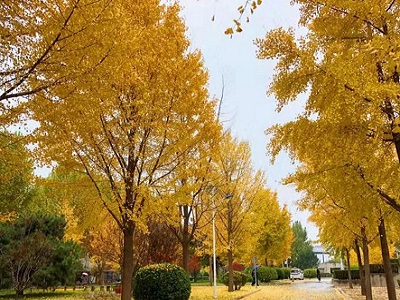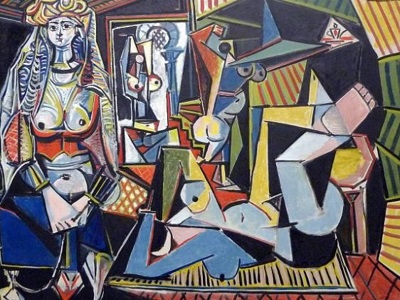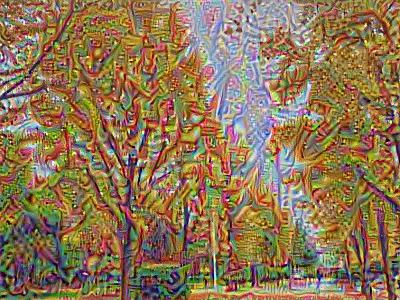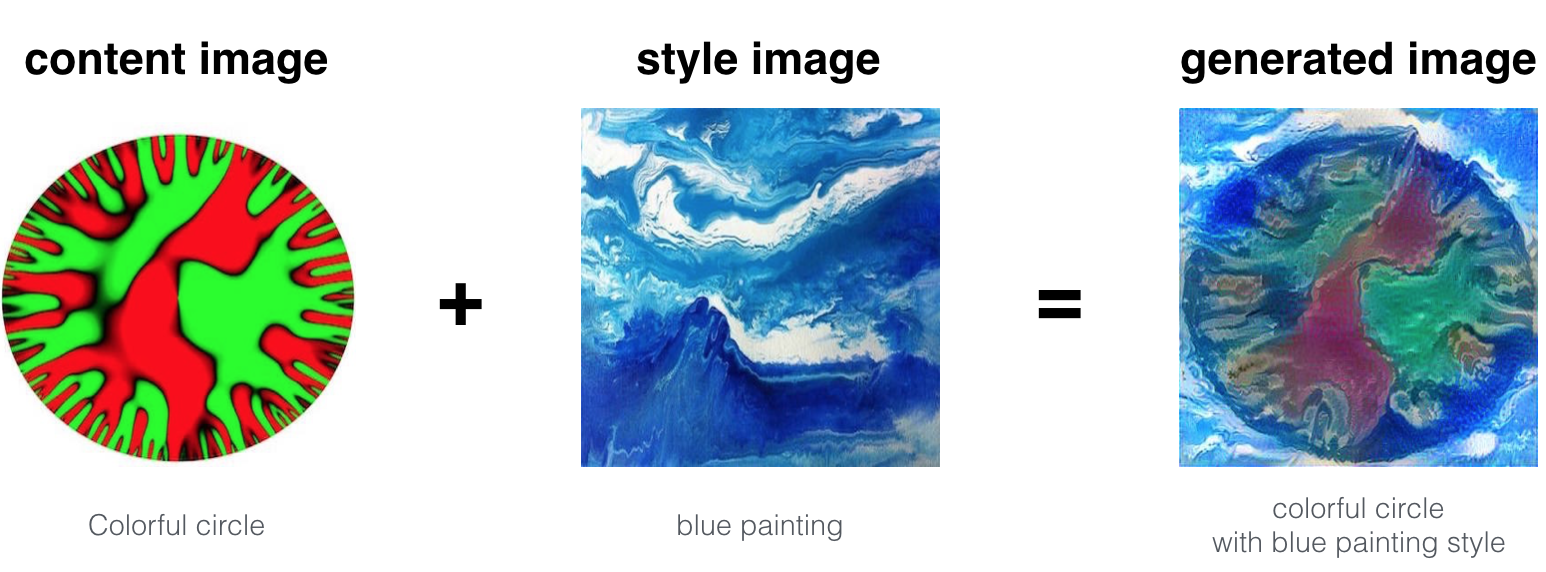Deep Learning & Neural Style Transfer(VGG) ——By何子辰
这周做了一个DeepLearning在Neural Style Transfer上应用的Assignment 。参考算法论文如下
Gatys et al. (2015) (https://arxiv.org/abs/1508.06576).
先上效果图:
① 美丽的中国石油大学(北京)+ 毕加索风格图像:(所有图像都预处理成400x300的图片)



②再放点其他的:


※※过程如下:
- Create an Interactive Session
- Load the content image
- Load the style image
- Randomly initialize the image to be generated
- Load the pretrained VGG16 model
- Build the TensorFlow graph:Initialize the TensorFlow graph and run it for a large number of iterations, updating the generated image at every step
- Run the content image through the VGG16 model and compute the content cost
- Run the style image through the VGG16 model and compute the style cost
- Compute the total cost
- Define the optimizer and the learning rate
VGG网格结构代码:
1 ### Part of this code is due to the MatConvNet team and is used to load the parameters of the pretrained VGG19 model in the notebook ###
2
3 import os
4 import sys
5 import scipy.io
6 import scipy.misc
7 import matplotlib.pyplot as plt
8 from matplotlib.pyplot import imshow
9 from PIL import Image
10 from nst_utils import *
11
12 import numpy as np
13 import tensorflow as tf
14
15 class CONFIG:
16 IMAGE_WIDTH = 400
17 IMAGE_HEIGHT = 300
18 COLOR_CHANNELS = 3
19 NOISE_RATIO = 0.6
20 MEANS = np.array([123.68, 116.779, 103.939]).reshape((1,1,1,3))
21 VGG_MODEL = 'pretrained-model/imagenet-vgg-verydeep-19.mat' # Pick the VGG 19-layer model by from the paper "Very Deep Convolutional Networks for Large-Scale Image Recognition".
22 STYLE_IMAGE = 'images/stone_style.jpg' # Style image to use.
23 CONTENT_IMAGE = 'images/content300.jpg' # Content image to use.
24 OUTPUT_DIR = 'output/'
25
26 def load_vgg_model(path):
27 """
28 Returns a model for the purpose of 'painting' the picture.
29 Takes only the convolution layer weights and wrap using the TensorFlow
30 Conv2d, Relu and AveragePooling layer. VGG actually uses maxpool but
31 the paper indicates that using AveragePooling yields better results.
32 The last few fully connected layers are not used.
33 Here is the detailed configuration of the VGG model:
34 0 is conv1_1 (3, 3, 3, 64)
35 1 is relu
36 2 is conv1_2 (3, 3, 64, 64)
37 3 is relu
38 4 is maxpool
39 5 is conv2_1 (3, 3, 64, 128)
40 6 is relu
41 7 is conv2_2 (3, 3, 128, 128)
42 8 is relu
43 9 is maxpool
44 10 is conv3_1 (3, 3, 128, 256)
45 11 is relu
46 12 is conv3_2 (3, 3, 256, 256)
47 13 is relu
48 14 is conv3_3 (3, 3, 256, 256)
49 15 is relu
50 16 is conv3_4 (3, 3, 256, 256)
51 17 is relu
52 18 is maxpool
53 19 is conv4_1 (3, 3, 256, 512)
54 20 is relu
55 21 is conv4_2 (3, 3, 512, 512)
56 22 is relu
57 23 is conv4_3 (3, 3, 512, 512)
58 24 is relu
59 25 is conv4_4 (3, 3, 512, 512)
60 26 is relu
61 27 is maxpool
62 28 is conv5_1 (3, 3, 512, 512)
63 29 is relu
64 30 is conv5_2 (3, 3, 512, 512)
65 31 is relu
66 32 is conv5_3 (3, 3, 512, 512)
67 33 is relu
68 34 is conv5_4 (3, 3, 512, 512)
69 35 is relu
70 36 is maxpool
71 37 is fullyconnected (7, 7, 512, 4096)
72 38 is relu
73 39 is fullyconnected (1, 1, 4096, 4096)
74 40 is relu
75 41 is fullyconnected (1, 1, 4096, 1000)
76 42 is softmax
77 """
78
79 vgg = scipy.io.loadmat(path)
80
81 vgg_layers = vgg['layers']
82
83 def _weights(layer, expected_layer_name):
84 """
85 Return the weights and bias from the VGG model for a given layer.
86 """
87 wb = vgg_layers[0][layer][0][0][2]
88 W = wb[0][0]
89 b = wb[0][1]
90 layer_name = vgg_layers[0][layer][0][0][0][0]
91 assert layer_name == expected_layer_name
92 return W, b
93
94 return W, b
95
96 def _relu(conv2d_layer):
97 """
98 Return the RELU function wrapped over a TensorFlow layer. Expects a
99 Conv2d layer input.
100 """
101 return tf.nn.relu(conv2d_layer)
102
103 def _conv2d(prev_layer, layer, layer_name):
104 """
105 Return the Conv2D layer using the weights, biases from the VGG
106 model at 'layer'.
107 """
108 W, b = _weights(layer, layer_name)
109 W = tf.constant(W)
110 b = tf.constant(np.reshape(b, (b.size)))
111 return tf.nn.conv2d(prev_layer, filter=W, strides=[1, 1, 1, 1], padding='SAME') + b
112
113 def _conv2d_relu(prev_layer, layer, layer_name):
114 """
115 Return the Conv2D + RELU layer using the weights, biases from the VGG
116 model at 'layer'.
117 """
118 return _relu(_conv2d(prev_layer, layer, layer_name))
119
120 def _avgpool(prev_layer):
121 """
122 Return the AveragePooling layer.
123 """
124 return tf.nn.avg_pool(prev_layer, ksize=[1, 2, 2, 1], strides=[1, 2, 2, 1], padding='SAME')
125
126 # Constructs the graph model.
127 graph = {}
128 graph['input'] = tf.Variable(np.zeros((1, CONFIG.IMAGE_HEIGHT, CONFIG.IMAGE_WIDTH, CONFIG.COLOR_CHANNELS)), dtype = 'float32')
129 graph['conv1_1'] = _conv2d_relu(graph['input'], 0, 'conv1_1')
130 graph['conv1_2'] = _conv2d_relu(graph['conv1_1'], 2, 'conv1_2')
131 graph['avgpool1'] = _avgpool(graph['conv1_2'])
132 graph['conv2_1'] = _conv2d_relu(graph['avgpool1'], 5, 'conv2_1')
133 graph['conv2_2'] = _conv2d_relu(graph['conv2_1'], 7, 'conv2_2')
134 graph['avgpool2'] = _avgpool(graph['conv2_2'])
135 graph['conv3_1'] = _conv2d_relu(graph['avgpool2'], 10, 'conv3_1')
136 graph['conv3_2'] = _conv2d_relu(graph['conv3_1'], 12, 'conv3_2')
137 graph['conv3_3'] = _conv2d_relu(graph['conv3_2'], 14, 'conv3_3')
138 graph['conv3_4'] = _conv2d_relu(graph['conv3_3'], 16, 'conv3_4')
139 graph['avgpool3'] = _avgpool(graph['conv3_4'])
140 graph['conv4_1'] = _conv2d_relu(graph['avgpool3'], 19, 'conv4_1')
141 graph['conv4_2'] = _conv2d_relu(graph['conv4_1'], 21, 'conv4_2')
142 graph['conv4_3'] = _conv2d_relu(graph['conv4_2'], 23, 'conv4_3')
143 graph['conv4_4'] = _conv2d_relu(graph['conv4_3'], 25, 'conv4_4')
144 graph['avgpool4'] = _avgpool(graph['conv4_4'])
145 graph['conv5_1'] = _conv2d_relu(graph['avgpool4'], 28, 'conv5_1')
146 graph['conv5_2'] = _conv2d_relu(graph['conv5_1'], 30, 'conv5_2')
147 graph['conv5_3'] = _conv2d_relu(graph['conv5_2'], 32, 'conv5_3')
148 graph['conv5_4'] = _conv2d_relu(graph['conv5_3'], 34, 'conv5_4')
149 graph['avgpool5'] = _avgpool(graph['conv5_4'])
150
151 return graph
152
153 def generate_noise_image(content_image, noise_ratio = CONFIG.NOISE_RATIO):
154 """
155 Generates a noisy image by adding random noise to the content_image
156 """
157
158 # Generate a random noise_image
159 noise_image = np.random.uniform(-20, 20, (1, CONFIG.IMAGE_HEIGHT, CONFIG.IMAGE_WIDTH, CONFIG.COLOR_CHANNELS)).astype('float32')
160
161 # Set the input_image to be a weighted average of the content_image and a noise_image
162 input_image = noise_image * noise_ratio + content_image * (1 - noise_ratio)
163
164 return input_image
165
166
167 def reshape_and_normalize_image(image):
168 """
169 Reshape and normalize the input image (content or style)
170 """
171
172 # Reshape image to mach expected input of VGG16
173 image = np.reshape(image, ((1,) + image.shape))
174
175 # Substract the mean to match the expected input of VGG16
176 image = image - CONFIG.MEANS
177
178 return image
179
180
181 def save_image(path, image):
182
183 # Un-normalize the image so that it looks good
184 image = image + CONFIG.MEANS
185
186 # Clip and Save the image
187 image = np.clip(image[0], 0, 255).astype('uint8')
188 scipy.misc.imsave(path, image)
接下来就是
# Deep Learning & Art: Neural Style Transfer
# This assignment:
# - Implement the neural style transfer algorithm
# - Generate novel artistic images using your algorithm
# - Most of the algorithms you've studied optimize a cost function to get a set of parameter values. In Neural Style Transfer, you'll optimize a cost function to get pixel values.
1 # Deep Learning & Art: Neural Style Transfer
2 # This assignment:
3 # - Implement the neural style transfer algorithm
4 # - Generate novel artistic images using your algorithm
5
6 # - Most of the algorithms you've studied optimize a cost function to get a set of parameter
7 # - values. In Neural Style Transfer, you'll optimize a cost function to get pixel values.
8
9 import os
10 import sys
11 import scipy.io
12 import scipy.misc
13 import matplotlib.pyplot as plt
14 from matplotlib.pyplot import imshow
15 from PIL import Image
16 from nst_utils import *
17 import numpy as np
18 import tensorflow as tf
19
20 # Essential params
21 class CONFIG:
22 IMAGE_WIDTH = 400
23 IMAGE_HEIGHT = 300
24 COLOR_CHANNELS = 3
25 NOISE_RATIO = 0.6
26 MEANS = np.array([123.68, 116.779, 103.939]).reshape((1,1,1,3))
27 VGG_MODEL = 'pretrained-model/imagenet-vgg-verydeep-19.mat' # Pick the VGG 19-layer model by from the paper "Very Deep Convolutional Networks for Large-Scale Image Recognition".
28 STYLE_IMAGE = 'HZC_test_image/2.jpg' # Style image to use.
29 CONTENT_IMAGE = 'HZC_test_image/bjs.jpg' # Content image to use.
30 OUTPUT_DIR = 'output/'
31
32 # STYLE weights
33 # When complete the assignment, come back and experiment with different weights to see
34 # how it changes the generated image G.
35 # default value:
36 # 权重不同,最终生成图像风格也不同
37 STYLE_LAYERS = [
38 ('conv1_1', 0.2),
39 ('conv2_1', 0.2),
40 ('conv3_1', 0.4),
41 ('conv4_1', 0.4),
42 ('conv5_1', 0.4)
43 ]
44
45 # - use a previously trained convolutional network, and build on top of that.
46 # - model: vgg-19; a 19-layer version of VGG network.
47 # - this model has already been trained in the very large ImageNet database.
48
49 # step 1: run the following model to load parameters from VGG model.
50 # Use load_vgg_model function in nst_utils.py
51 model = load_vgg_model("pretrained-model/imagenet-vgg-verydeep-19.mat")
52 # print(model)
53
54 # CONTENT image
55 content_image = scipy.misc.imread("images/louvre.jpg")
56 imshow(content_image)
57
58 # STYLE image
59 style_image = scipy.misc.imread("images/monet_800600.jpg")
60 imshow(style_image)
61
62 #Tool that was necessary
63
64 # Reshape and normalize the input image (content or style)
65 def reshape_and_normalize_image(image):
66
67 # Reshape image to mach expected input of VGG16
68 # image = np.reshape(image,(300,400,3))
69 image = np.reshape(image,((1,)+image.shape))
70
71 # Substract the mean to match the expected input of VGG16
72 image = image - CONFIG.MEANS
73 return image
74
75 # Generate a noisy image bt adding random noise to the content_image
76 def generate_noise_image(content_image,noise_ratio = CONFIG.NOISE_RATIO):
77
78 # Generate a random noise_image
79 noise_image = np.random.uniform(-20,20, (1, CONFIG.IMAGE_HEIGHT, CONFIG.IMAGE_WIDTH, CONFIG.COLOR_CHANNELS)).astype('float32')
80
81 # Set the input_image to be a weighted average of the content image and a noise image
82 input_image = noise_image*noise_ratio + content_image*(1 - noise_ratio)
83
84 return input_image
85
86 #Save image
87 def save_image(path, image):
88
89 # Un-normalize the image so that it looks good
90 image = image + CONFIG.MEANS
91
92 # Clip and Save the image
93 image = np.clip(image[0], 0, 255).astype('uint8')
94 scipy.misc.imsave(path, image)
95
96 # Compute the Content Cost use Tensorflow
97 def compute_content_cost(a_C,a_G):
98 """
99 Compute the Content Cost
100
101 Arguments:
102 a_C >>> tensor of dimension(1,n_h,n_w,n_c) hidden layer activations
103 a_G >>> tensor of dimension(1,n_h,n_w,n_c) hidden layer activations
104
105 Returns:
106 J_content >>> scalar that you compute using equation that you needed
107
108 """
109 # Retrieve params
110 m,n_H,n_W,n_C = a_G.get_shape().as_list()
111
112 # Reshape a_C and a_G
113 a_C_unrolled = tf.reshape(a_C,[n_H*n_W,n_C])
114 a_G_unrolled = tf.reshape(a_G,[n_H*n_W,n_C])
115
116 # Compute the cost with tensorflow
117 params = 1/(4*n_H*n_W*n_C)
118 J_content = params*(tf.reduce_sum(tf.square(tf.subtract(a_C_unrolled,a_G_unrolled))))
119
120 return J_content
121
122
123 # Gram_matrix (Style matrix)
124 def gram_matrix(A):
125 """
126 Argument:
127 A -- matrix of shape(n_C, n_H,n*W)
128
129 Returns:
130 GA -- Gram matrix of A: shape(n_C,n_C)
131 """
132 GA = tf.matmul(A,tf.transpose(A))
133
134 return GA
135
136 # Style cost
137 # We only use a single layer l
138 def compute_layer_style_cost(a_S,a_G):
139 """
140 Arguments:
141 a_S -- tensor of dimension(1,n_H,n_W,n_C), hidden layer activations representing style
142 a_G -- tensor of dimension(1,n_H,n_W,n_C), hidden layer activations
143 Returns:
144 J_style_layer -- tensor representing a scalar value(标量), style cost
145 """
146
147 # Retrieve params from a_G
148 m,n_H,n_W,n_C = a_G.get_shape().as_list()
149
150 # Reshape the images to have them of shape(n_C, n_H*n_W)
151 a_S = tf.reshape(a_S, [n_C,n_H*n_W])
152 a_G = tf.reshape(a_G, [n_C,n_H*n_W])
153
154 # Compute gram matrix for both images S and G
155 GS = gram_matrix(a_S)
156 GG = gram_matrix(a_G)
157
158 # Compute the loss
159 params = 1/(4*(n_C**2)*((n_H*n_W)**2))
160 J_style_layer = params*(tf.reduce_sum(tf.square(tf.subtract(GS,GG))))
161
162 return J_style_layer
163
164 # Combine the style costs for different layers as follows:
165 def compute_style_cost(model,STYLE_LAYERS):
166 """
167 Computes the overall style cost from several chosen layers.
168
169 Arguments:
170 model -- our tensorflow model
171 STYLE_LAYERS -- A python list contains:
172 -- the names of the layers we would like to extract style from
173 -- a coefficient for each of them
174 Returns:
175 J_style -- tensor representing a scalar value
176 """
177 # The overall style cost
178 J_style = 0
179
180 for layer_name, coeff in STYLE_LAYERS:
181 # Select the output tensor
182 out = model[layer_name]
183
184 # Set a_S to be the hidden layer activation that we have selected.
185 a_S = sess.run(out)
186 # U don't have to do it again
187 # Set a_G to be the hidden layer activation from same layer.
188 a_G = out
189
190 # Compute style_cost for the current layer
191 J_style_layer = compute_layer_style_cost(a_S, a_G)
192 # Add coeff
193 J_style += coeff * J_style_layer
194
195 return J_style
196
197 # Define the total cost to optimize
198 def total_cost(J_content, J_style, alpha=10, beta=40):
199 """
200 Compute the total cost function
201
202 alpha>>> hyperparameter weighting the importance of the content cost
203 beta >>> hyperparameter weighting the importance of the style cost
204
205 Returns:
206 J -- total cost as defined by the formula above.
207 """
208 J = alpha*J_content + beta*J_style
209 return J
210
211 # Solving the optimization problem
212 # STEP1: Create an interactive session:
213 tf.reset_default_graph()
214
215 sess = tf.InteractiveSession()
216
217 # STEP2: Load the content&style image
218 content_image = scipy.misc.imread("HZC_test_image/2.jpg")
219 content_image = reshape_and_normalize_image(content_image)
220 print(content_image.shape)
221 style_image = scipy.misc.imread("HZC_test_image/bjs.jpg")
222
223 style_image = reshape_and_normalize_image(style_image)
224 print(style_image.shape)
225 # STEP3: Randomly initialize the image to be generated
226 generated_image = generate_noise_image(content_image)
227 # print(generated_image.shape) # 1x300x400x3
228 imshow(generated_image[0])
229
230 # STEP4: Load the VGG16 model
231 model = load_vgg_model("pretrained-model/imagenet-vgg-verydeep-19.mat")
232
233 # STEP5: Build the tensorflow graph
234
235 # Run the content image through the VGG16 model and compute the content cost
236 # Assign the content image to be the input of the VGG model
237 sess.run(model['input'].assign(content_image))
238 # Select the output tensor of the layer conv4_2
239 out = model['conv4_2']
240 # Set a_C to be the hidden layer activation from the layer we have selected
241 a_C = sess.run(out)
242 a_G = out
243 J_content = compute_content_cost(a_C, a_G)
244
245 # Run the style image through the VGG16 model and compute the style cost
246 # Assign the input of the model to be the "style" image
247 sess.run(model['input'].assign(style_image))
248 J_style = compute_style_cost(model, STYLE_LAYERS)
249
250 # Compute the total cost
251 J = total_cost(J_content, J_style, alpha=10, beta=40)
252
253 # Define the optimizer and the learning rate
254 # optimizer
255 optimizer = tf.train.AdamOptimizer(2.0)
256 # train_step
257 train_step = optimizer.minimize(J)
258
259 # STEP6: Initialize the TensorFlow graph and run it for a large number of iterations,
260 # updating the generated image at every step.
261 def model_nn(sess,input_image,num_iterations=200):
262
263 # Initialize the global variables
264 sess.run(tf.global_variables_initializer())
265
266 # Run the noisy input image
267 sess.run(model['input'].assign(input_image))
268
269 for i in range(num_iterations):
270
271 # Run the session on the train_step to minimize the total cost
272 sess.run(train_step)
273
274 # Compute the generated image by runing the session on the
275 # Current model['input']
276 generated_image = sess.run(model['input'])
277
278 # Print every 20 iterations
279 if i%20 == 0:
280 Jt,Jc,Js = sess.run([J, J_content, J_style])
281 print("iterations"+str(i)+":")
282 print("total cost ="+str(Jt))
283 print("content cost = "+str(Jc))
284 print("style_cost = "+str(Js))
285
286 save_image("output/generated_image_cup.jpg", generated_image)
287 # Save last generate image
288 save_image('output/generated_image_cup.jpg',generated_image)
289
290 return generated_image
291
292 model_nn(sess, generated_image, num_iterations=200)
293
294
295
296 # plt.show()
297
298 # Test code for "compute_content_cost"
299 # tf.reset_default_graph()
300
301 # with tf.Session() as test1:
302 # tf.set_random_seed(1)
303 # a_C = tf.random_normal([1,4,4,3],mean=1,stddev=4)
304 # a_G = tf.random_normal([1,4,4,3],mean=1,stddev=4)
305 # J_content = compute_content_cost(a_C, a_G)
306
307 # print("J_content="+str(J_content.eval()))
308
309 # # Test code for "gram_matrix"
310 # tf.reset_default_graph()
311
312 # with tf.Session() as test2:
313 # tf.set_random_seed(1)
314 # A = tf.random_normal([3,2*1], mean=1, stddev=4)
315 # GA = gram_matrix(A)
316
317 # print("GA = " + str(GA.eval()))
318
319 # Test code for "compute_layer_style_cost "
320 # tf.reset_default_graph()
321
322 # with tf.Session() as test3:
323 # tf.set_random_seed(1)
324 # a_S = tf.random_normal([1,4,4,3],mean=1,stddev=4)
325 # a_G = tf.random_normal([1,4,4,3],mean=1,stddev=4)
326 # J_style_layer=compute_layer_style_cost(a_S, a_G)
327 # print("J_style_layer = " + str(J_style_layer.eval()))
328
329 # Test code for "total_cost"
330 # tf.reset_default_graph()
331
332 # with tf.Session() as test:
333 # np.random.seed(3)
334 # J_content = np.random.randn()
335 # J_style = np.random.randn()
336 # J = total_cost(J_content, J_style)
337 # print("J = " + str(J))



 浙公网安备 33010602011771号
浙公网安备 33010602011771号